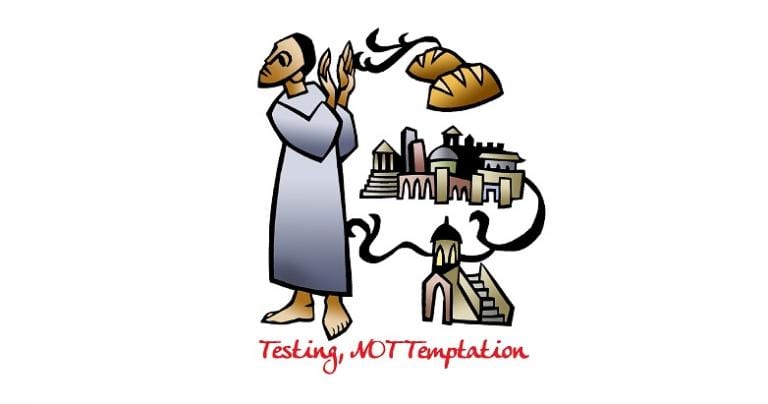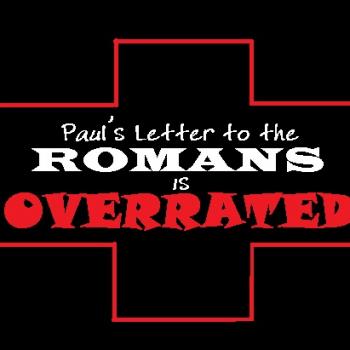
Satan was testing Jesus, not tempting him as popularly imagined—and Jesus successfully passed his trials.
Scripture scholars recognize that “Mark” was the first narrative gospel. Consider the primitive version of the story about the Devil testing Jesus found in “Mark.” Since it was the earliest narrative-Gospel, it becomes easy to see how “Matthew” and “Luke” both embellished the Markan original by incorporating three specific temptations. This video presentation explains—
Testing Old Man Jesus
Mark 1:12
The Spirit drove Jesus out into the desert,
Stop. What is going on?
Jesus was old if he began his ministry when “Luke” says he did (see Luke 3:23). Paleopathological studies examining abundant skeletal remains from Herodian Palestine paint an awful picture of Jesus’ physical condition. By thirty years old, a Galilean peasant suffered poor health, severe dental issues, and faced imminent blindness due to trachoma. Malnutrition, terrible hygiene, ridden with parasites and lice, would all take their toll on Jesus.
This is the Jesus who left the Baptizer-Movement to begin his own political faction. If you are reading this, you are probably way too old for Sunday school kitsch.
This is also the Jesus who goes further into the desert to confront Satan. To see what I mean, let’s back up to the previous scene.
Testing the Holy Man, According to Mark
Mark 1:9-11
It happened in those days that Jesus came from Nazareth of Galilee and was baptized in the Jordan by John. On coming up out of the water, he saw the sky-vaults being torn open and the Spirit, like a dove, descending upon him. And a voice came from the sky-vaults, “You are my beloved Son; with you I am well pleased.”
“Mark” began his Gospel by assuring his audience Jesus was “the son of God.” Although the Church eventually came to understand Jesus as divine, the Second Person of the Trinity, that wasn’t what the expression “son of God” meant in “Mark.” To Hellenist Israelites back in the first century, “son of God” meant “holy person” (see Mark 1:24), what anthropologists would call a “shaman.”
The Israelite tradition recognized two kinds of shamanic “holy men,” the saddiq and the hasid. Whereas the saddiq observed the basic requirements of the Torah, the hasid would strive to go beyond. Which of these does “Mark” imagine Jesus to be?
Testing Why Jesus Needed To Be With John
Recently, we discussed why Jesus went out to John the Baptist in the first place. Did John, by his preaching, motivate Jesus to repent and submit to his baptism? But wait a minute—don’t we believe that Jesus was without any sin! How then could Jesus repent? Of course, over the past two millennia, believers have not always understood sin in the same way.
Wisely dropping the typical crypto-Docetism hiding behind a cloak of verbal orthodoxy is a good move if we wish to understand Jesus, fellow Catholics. Put yourself in the sandals of the prepaschal Jesus. Is it impossible that he could have believed that maybe he cheated a customer in his manual labor, even if he did so unintentionally?
Why would he go to John? I mean before the Evangelists polished things. Remember that the Baptizer proclaimed “forgiveness of sins.” To a peasant like Jesus, “forgive” would be inexorably linked with canceling debts. Even sinless (however we define “sin”), as a starving Galilean peasant artisan, you better believe Jesus needed debt-cancellation!
Death to Group-Self
Keep in mind what we discussed earlier—Jesus had to leave his village and family (i.e., die to his group-self) to meet John in the wilderness. In turn, the Baptist-group became Jesus’ new group-self. It was a new, surrogate kinship network, much like the later one composed of his own followers (Mark 3:33-35).
Once John dips Jesus into the Jordan, both Jesus and his Dunker experience an altered state of consciousness experience (Mark 1:10-11). According to “Mark,” this is the formal calling and initiation of Jesus as a holy man—”You are my attached-son…” Cross-cultural studies reveal six steps to being a holy person, detailed in the video, here—
Guaranteed Testing
In the Markan baptism scene, God honors Jesus with great favor. Every Mediterranean hearing or reading this Gospel understood that the myriads of spirits densely populating the winds around could not escape hearing that compliment.
Every Mediterranean knows what must happen next. Someone with an envious Evil Eye will soon be testing Jesus. A spirit, guaranteed, must test the honor claim. Does this lowly nothing-person deserve this honor-claim? Is God really attached to him? A son, eh? Well then, is he genuinely loyal, like all real sons are? Let’s find out!
Reading the Gospel with eyes sensitive to the Mediterranean cultural setting, the temptation of Jesus by Satan becomes inevitable. No claim to honor in the Mediterranean world (Mark 1:11) escapes a test, a trial by ordeal. All compliments must be proven worthy.
By the way, before Satan theologically merged with the Devil (originally two completely different Persian concepts), he was God’s secret agent. The satan originally was a spy who performed the dirty work of testing loyalty. Watch this video presentation here—
Horrific Testing & Celestial Kin
Mark 1:12-15
The Spirit drove Jesus out into the desert,
and he remained in the desert for forty days,
tempted by Satan.
He was among wild beasts,
and the angels ministered to him.
This is a horror story, folks, one of many in the Bible. Jesus seems completely alone (unthinkably horrific to Mediterraneans) in a place notoriously haunted by demons. Jesus was dead to his Nazareth-group-self! And now, even his new Baptist-self is nowhere around! Who will come to his aid? Alone and vulnerable, Jesus is in danger. At least he seems to be.
But then we learn that Jesus has a new social network—a celestial kinship group made up of angels (personified constellations and stars) that assist him and minister to him. Ultimately then, Jesus was not alone!
Matthew and Luke use “Q” to Embellish the Story
But isn’t something missing? Readers familiar with the Temptation story in “Matthew” and “Luke” (Matthew 4:1-11; Luke 4:1-13) may find the earlier Markan story odd. Where is the elaborate back-and-forth contest of wills between Satan and Jesus? No dialogue is mentioned in the Markan account of this testing.
“Mark” (ca. 70 CE) briefly mentions that Satan put Jesus to the test (1:12-13). But look how “Matthew” (ca. 80s) and “Luke” (ca. 90s) embellish this, detailing three trials, but disagree on the exact order. From where did this more comprehensive report come?
Scholars believe that both “Matthew” and “Luke” had a copy of “Mark” handy when they wrote their Gospels. But they also had another source of Jesus-sayings. Scholars call it “Q,” the initial to the German word for source, Quelle). Sometime, probably in the 50s CE, disciples compiled this source.
Testing, NOT Temptation
By the way, this is not really a “temptation” story. Instead, this is a story about honor testing. Jesus is being put to the test. Satan is testing to see if Jesus really is worthy of the outstanding reputation as God’s beloved son proclaimed by the sky-voice at his baptism. Suppose Jesus is a Mediterranean son (the only kind of son biblical people know or care about). In that case, he must be undyingly loyal. Hence, Satan is testing Jesus’ loyalty.
Even though both “Matthew” and “Luke” agree on the three trials of the loyalty testing experience, they disagree on the exact sequence. That raises the question—what order did “Q” have, originally?
Scholars like John Pilch think that “Matthew” followed the original order as kept in “Q” (bread-Temple-mountain). This is because the cited passages from Deuteronomy are given in reverse-order sequence (Deuteronomy 8:3; Deuteronomy 6:16; Deuteronomy 6:13). It seems that “Luke” got creative with “Q,” switching the Temple to be the final trial because of how he features it in his Gospel narrative.
But none of this is in “Mark.” Despite this, it is a safe bet that the Markan Jesus successfully defends his honor as a (Mediterranean) son pleasing and attached to God (Mark 1:1).
Testing Mark’s Embarrassment
Mark 1:14-15
After John had been arrested,
Jesus came to Galilee proclaiming the Gospel of God:
“This is the time of fulfillment.
The kingdom of God is at hand.
Repent, and believe in the Gospel.”
These verses describe Jesus starting his own ministry. Something was left out, however, by “Mark” between verses 13 and 14. What “Mark” omitted was probably due to embarrassment. Embarrassed? About what?
The basic message of John the Baptist and Jesus was Israelite theocracy, the kingdom of God. Notice how Jesus proclaims repenting and believing the good news in Mark 1:15? It’s eerily similar to John’s own proclamation (Mark 1:3). According to many scholars, including Pilch, this suggests that initially, John was Jesus’ leader and shamanic teacher (see Mark 6:14, 20).
How shocking it must have been when John got arrested. Jesus and his fellow followers were now without a leader. Neither Jesus nor his peers in the Baptist-group were American individualists. With the faction-leader gone, this had devastating effects on the political faction.
Mark Smooths Things Out
“Mark” summarizes and simplifies all of this. With his master arrested, Jesus assumes his prophetic role and proclaims the will of God concerning theocracy. Success at healing and exorcism encouraged Jesus to recruit his own followers into a new faction—the Jesus Movement. Doing this, he did not dishonor the Baptist! Instead, he continued his work as a son of God.
Who knew that baptized followers centuries later would be guided by the Spirit in the Church in the way things worked out? We’ve come a long way! The Church came to recognize Jesus not just as a “son of God” (i.e., holy man) and as God the Son, eternally begotten of the Father.
More this week on the Jesus Movement and beyond…












